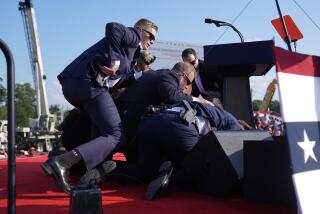When the Walls Have Ears : Latest plan for re-securing Moscow embassy deserves congressional support
- Share via
The U.S. embassy in Moscow is probably this country’s most important overseas diplomatic and intelligence listening post. It is also scandalously insecure and unsafe.
The 10-story former apartment house has repeatedly been penetrated by Soviet secret services. In addition, both Congress and the State Department have pronounced the building a “firetrap.” Why not abandon this archaic heap and relocate in a safer, more modern facility? The American and Soviet governments agreed on such a plan in the 1970s, and new embassies for each began to go up in Moscow and Washington. But in 1985, when work on the U.S. building was about two-thirds completed, American inspectors discovered that Soviet construction crews had sown scores, maybe hundreds, of listening devices throughout the multimillion-dollar structure. Work was halted while successive administrations and Congress tried to figure out what to do.
Five weeks ago, yet another fire broke out in the old embassy. The Bush Administration now confirms that Soviet firefighters who rushed in to combat the blaze were joined by KGB agents whose purposes were less high-minded. What the KGB was able to steal, copy, retrieve or compromise may never be fully known. The State Department, in its first detailed accounting, concedes that some classified computer disks and other documents were removed, but says “preliminary findings” indicate the building’s most sensitive areas were “appropriately locked.” In any event, the embassy--porous to Soviet eavesdropping since at least the early 1960s--has again been shown to be among the most vulnerable of overseas diplomatic missions.
Enough is enough. It’s time to end the argument over what to do about the forsaken new embassy building. It would cost hundreds of millions to tear it down and build a secure facility in its place, as the Administration has proposed. It would cost far less to salvage as much of the building as possible and make secure additions to it.
That is what the State Department and the Central Intelligence Agency have both recommended. The House Foreign Affairs Committee has now voted unanimously for just such a rescue operation. It approved putting four new floors on top of the building, to be built, according to Rep. Howard L. Berman (D-Panorama City), with American workers and materials. That stipulation, inexplicably absent from the earlier U.S.-Soviet agreement on embassy construction, should presumably permit greater confidence that this time around the walls won’t have ears, a welcome change from what embassy personnel have for so long had to live with.
More to Read
Sign up for Essential California
The most important California stories and recommendations in your inbox every morning.
You may occasionally receive promotional content from the Los Angeles Times.













